Split Snatch Exercise: How To, Benefits & Variations
Author:
Unlock your full potential by engaging with our experts and community! Have questions about your fitness journey or looking for expert advice on weightlifting techniques? Don’t hesitate — leave a comment below and Oleksiy Torokhtiy will provide a personalized answer and insights to help you reach your goals.
Torokhtiy is reader-supported. Some links are affiliate links, and we may earn a commission at no extra cost to you. See our disclosure page for details.
The split snatch is a powerful move that will build your strength, and improve balance, coordination, and agility. If your routine is feeling a little blah and you’re looking for something explosive, dynamic to add to it, this is where it’s at.
If you don’t quite know what the split snatch is, how to do it, and why should you even bother with it, you’re in the right place because we’ll cover all of that and more. We have a bunch of expert tips, advice, variations, and even alternatives for you. Basically, we have everything you’d ever want to know about the split snatch.
Alright, let’s split snatch!
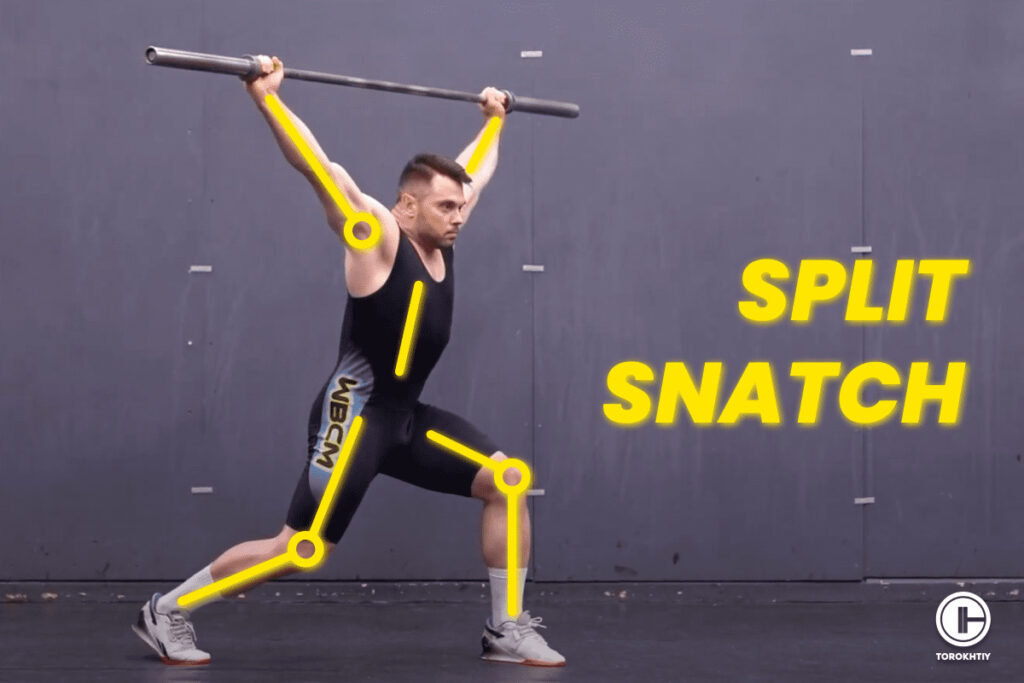
What Is the Split Snatch?
Looking at the name, you’d think there’s an actual split involved, but that would be… Ouch. Let’s just leave it at that. It’s not that hard to do, don’t worry!
At its core, the split snatch is a variation of the classic snatch, meaning you lift the barbell off the ground to an overhead position in one smooth motion. It’s an exercise that combines the elements of strength, speed, and agility.
What’s the point of the split snatch if the snatch already exists, you ask? Well, the footwork is different with the split snatch and that’s what makes it different. Instead of landing on your feet parallel and shoulder-width apart, you land in a split stance with one foot forward and the other back. This stance might help you improve balance and stability, which then makes the lift more controlled and precise.
The reason why you would even bother with the split snatch is to improve your overall athletic performance because this is an exercise that will improve your explosive power, coordination, and flexibility.
Save it for easy access!
Bookmark this page now to access the program and instructional videos anytime, anywhere.
Stop wasting time searching during your gym sessions.
How to Do the Split Snatch?
If you’re new to this, you’re probably both curious and intimidated, but there’s no place for intimidation here because, when you divide it into steps, you’ll see it’s not as complicated and scary as you might think.
You don’t have to do it all at once. In fact, it would be great to practice the split stance and the overhead position separately before you combine them to really get the hang of it.
1. Set Up Your Stance – Starting Position
The first thing you need to do is to get in the correct stance. Your feet should be shoulder-width apart and the barbell should be on the ground in front of you. Point your toes out a little.
Bend at the hips and knees, grip the bar with a hook grip, with hands just outside your knees and shoulders over the bar. Keep your back straight, chest up, and eyes forward.
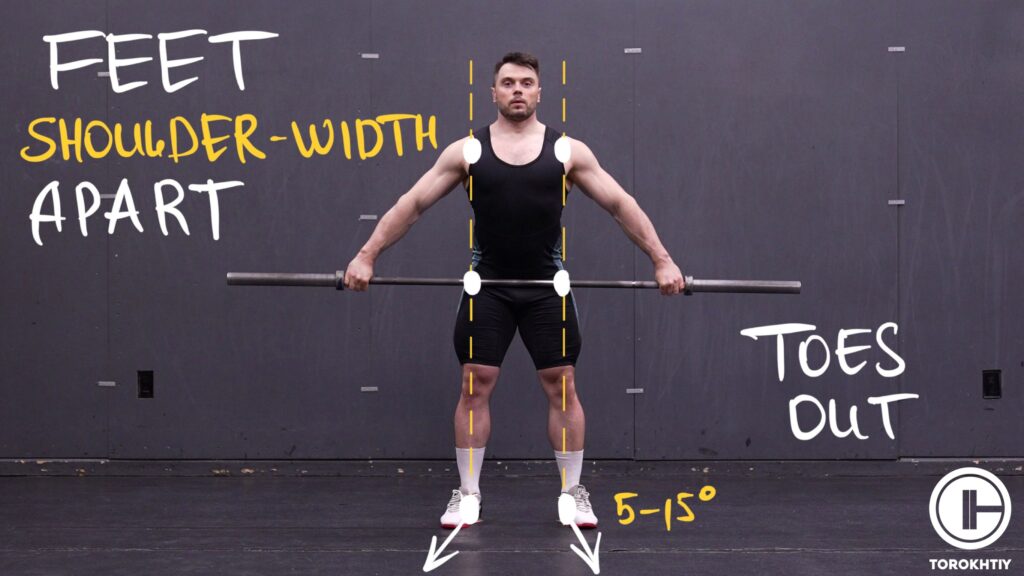
2. Lift the Barbell (First Pull)
Now it’s time to lift the barbell. Push through your feet to lift it off the ground. Make sure to keep it close to your body, and to keep your back straight.
All of this needs to be steady and controlled and your legs and back muscles should be engaged.
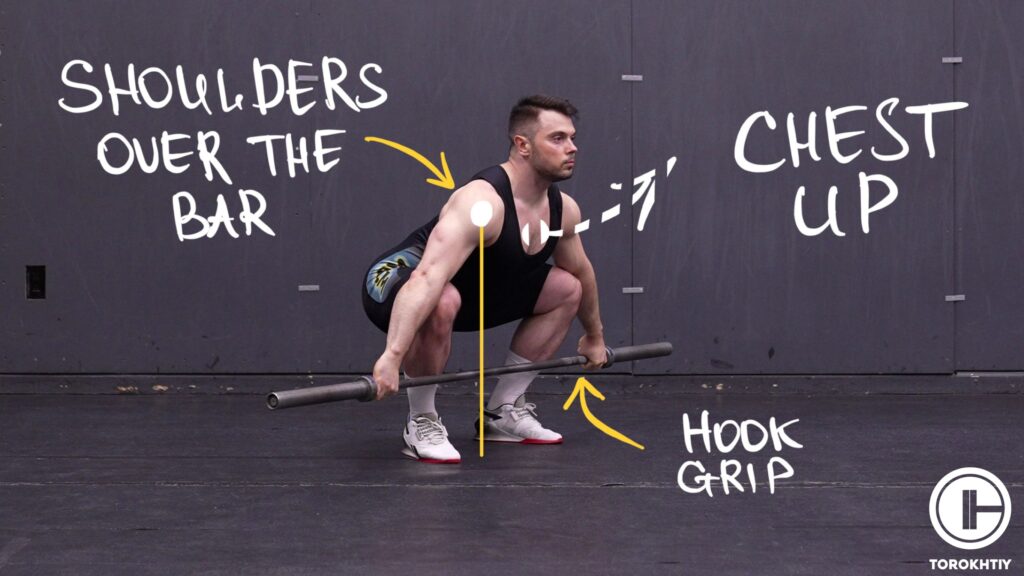
3. Second Pull
As the bar passes your knees, drive your hips forward and extend your hips and knees explosively. This is a powerful, quick movement that should lift the barbell up and create momentum.
Your shoulders need to stay above the bar until this point.
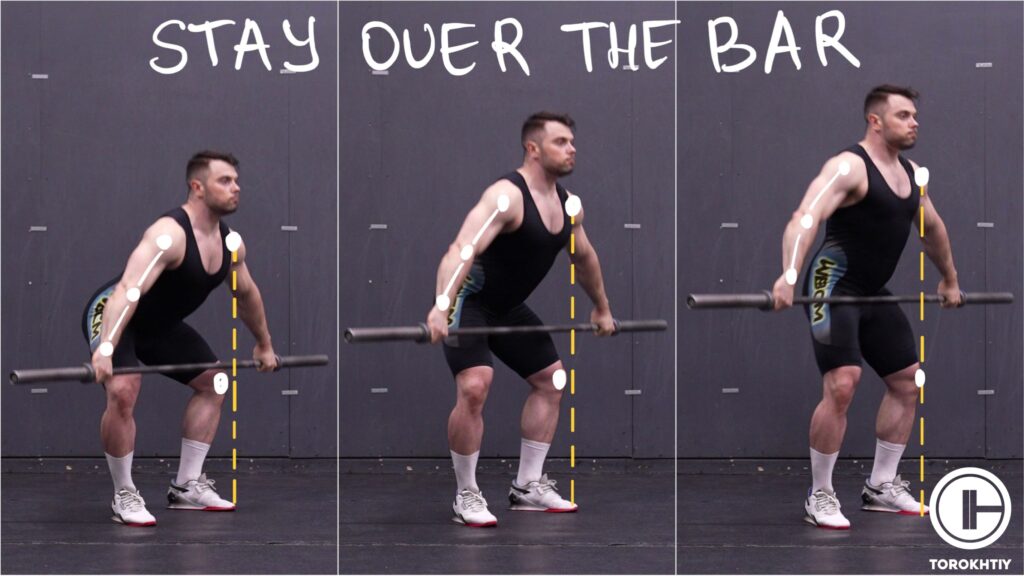
4. Power Position and Turnover
The bar reaches the highest point while still being in full contact with the body – power position. Finish triple extension and quickly turn under the bar. Rotate your elbows and wrists to catch it overhead.
Now, this is where the split stance comes into play. As you turn over the bar, split your feet so that one foot goes forward and the other one moves back.
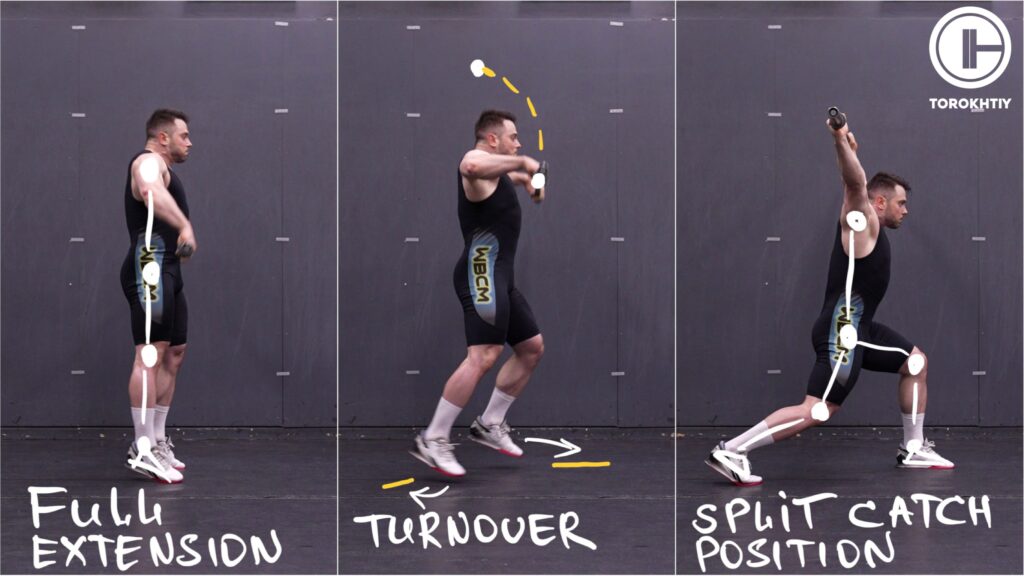
5. Catch
The catch is incredibly important for stability. Your front knee should be bent at about 90-110 degrees and your back leg should be slightly bent. The barbell should now be directly over your head and your arms should be completely extended with your shoulders engaged and stable.
Make sure your back is straight and your core engaged, otherwise you won’t be able to support the lift.
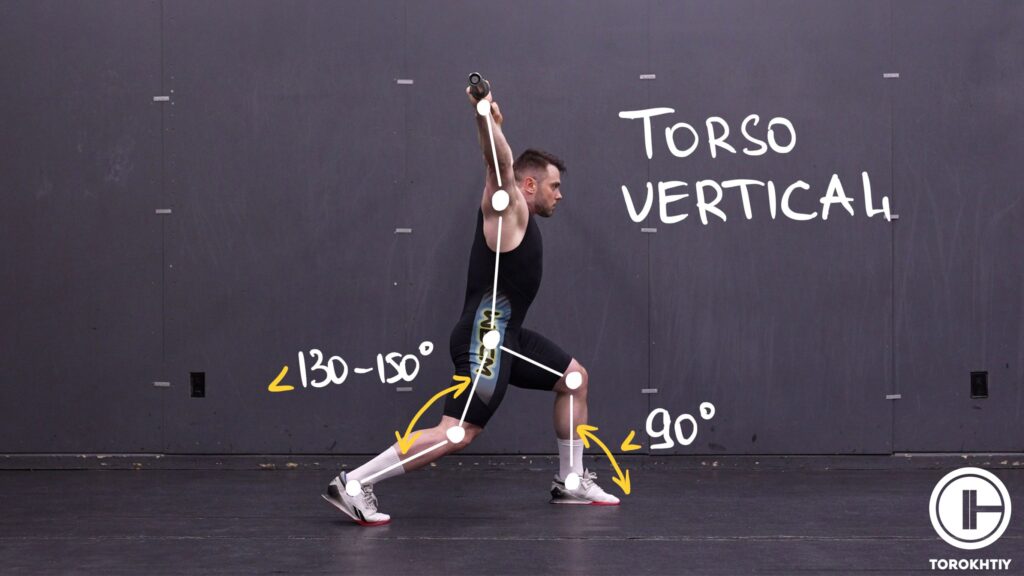
6. Recovery – Stabilize
Once you’ve caught the bar in the split stance, hold that position for a moment to stabilize yourself. Then, bring your feet back to a parallel stance – move your front foot back first, then move your back foot forward. Keep the barbell locked over your head.
7. Lower the Barbell
Now all that’s left to do is to lower the barbell back to the ground. To do this, bring your feet together into a stable position, bend the hips and knees and guide the barbell down in a controlled way.
And that’s it! You just did a split snatch!
A Simple Split Snatch Program
You’d like to give it a try but don’t know where to start? We’ve got your back!
Beginner
- Start with 3-4 sets, with 4-6 reps per set
- Do the split snatch 1-2 times a week
- Focus on technique and start with lighter weights or just the bar without any plates. Once you can complete all reps easily, add 5-10 pounds to the barbell
Intermediate
- Do 4-5 sets, with 4-6 reps per set
- Do the split snatch 2-3 times per week
- Increase the weight in small increments; once you can comfortably lift a challenging weight for the set number of reps
Advanced
- Do 5-6 sets, with 3-5 reps per set
- Do the split snatch 3 times per week
- Increase the weight and intensity continuously to keep it challenging. Experiment with snatch complexes.
Tips From the Champ
Trying this variation during off season can help weightlifters to develop greater stability and strength in their legs and shift a bit from traditional snatch technique.
Olympic Weightlifting Champion
3 Common Split Snatch Mistakes
Everybody knows you need to warm up before your workout and then you need to cool down after. Still, some people either forget or just think they can skip these steps – don’t be one of those people.
Apart from this, there are some other mistakes that are pretty common, and they concern the split snatch specifically.
❌ Improper Foot Positioning
This is one of the most common mistakes – landing with your foot positioning being off. Some people place their feet too narrow, others too wide, but whatever the case, it will mess up your stability and balance.
Practice the stance separately to get the feel of the correct positioning. Good way to start is shoulder width stance.
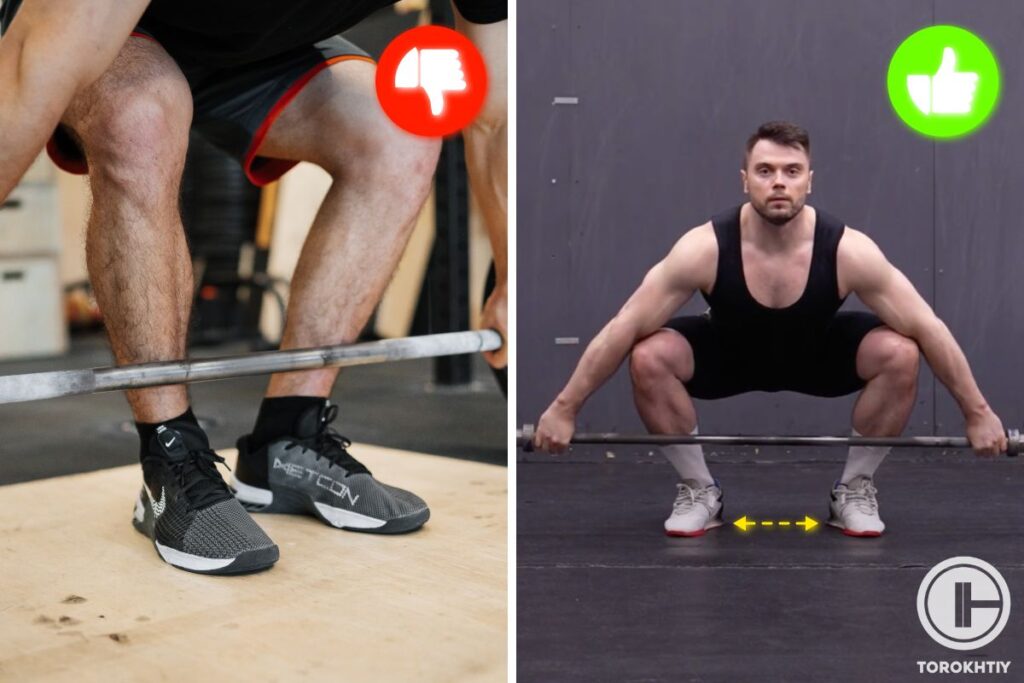
❌ Pulling Too Early
This is a mistake a lot of beginners make because they’re impatient and want to complete the lift quickly – they pull the barbell up with arms before it’s reached the appropriate height.
If you have a problem with this, too, practice the first and second pull separately to improve your technique. Hang Snatch also might help.
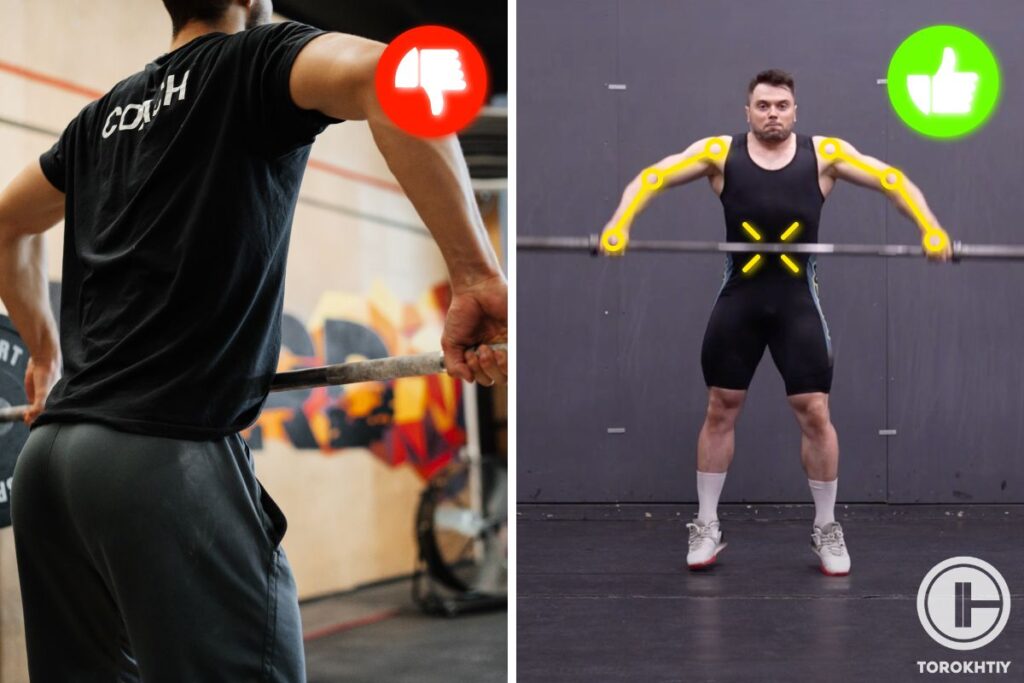
❌ Going Too Heavy Without Mastering the Technique
A lot of people either get impatient or they overestimate their abilities and try to lift too heavy without first mastering the technique. This will result in a wobbly, unstable lift, and the risk of injury will skyrocket.
Focus on mastering the form and technique first and use manageable weights until you do that.
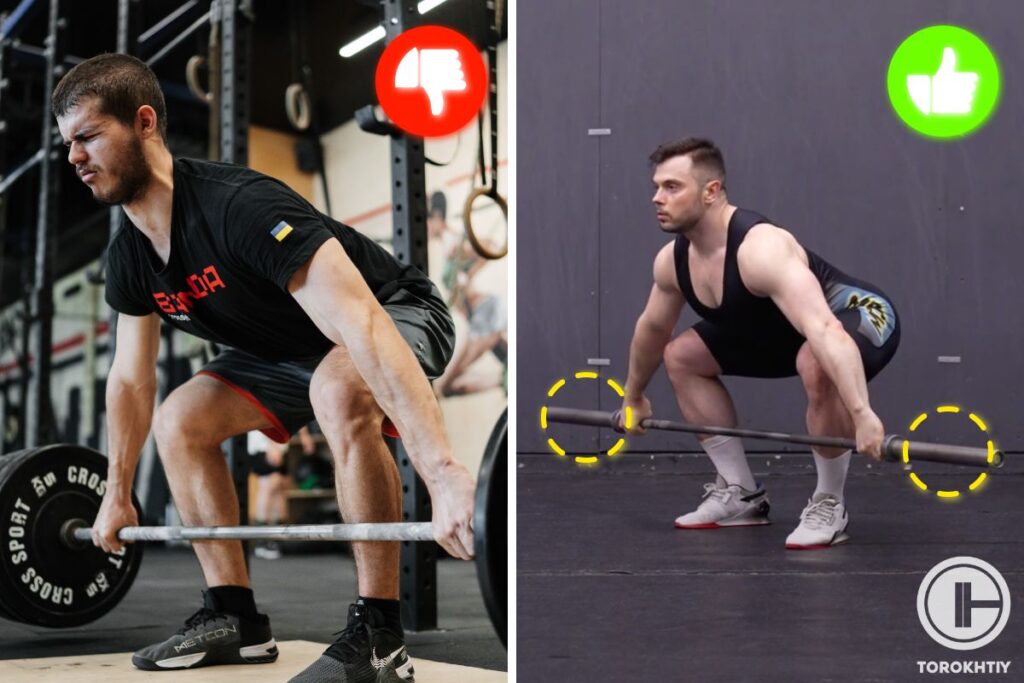
4 Benefits of Split Snatch
Okay, we’ve talked your ear off about form, technique, how to do it properly, etc. You might still be lacking motivation to actually do it, though, because you may not know how useful it is.
Let’s talk you into giving the split snatch a try!
✅ Improved Full-Body Strength
The split snatch engages multiple muscle groups at the same time, so it’s a very effective exercise to build strength in your entire body. Legs, glutes, core, shoulders, arms… Almost every major muscle group is activated.
✅ Better Balance and Stability
You’ve probably noticed that the split snatch needs precision and coordination, and this can improve your balance and stability a lot. Landing in a split stance will challenge your proprioception and force you to stabilize your body while you’re holding a weighted barbell over your head.
✅ Calorie Burning
It’s a high-intensity, full-body exercise, so it torches calories. Since it’s so explosive, it won’t just burn calories, but also can create an afterburn effect (EPOC). This means you may burn calories even after you stop working out.
✅ Improved Bone Density
The split snatch is a weight-bearing exercise, and those will improve your bone density. The force placed on your bones during the exercise stimulates bone cells called osteoblasts, which are responsible for building new bone tissue.
Follow us!

Free!
Get a 2-week Weightlifting Program as a bonus for the subscription to kickstart your training plan!

Free!
4 Split Snatch Alternatives
Alternatives can be a breath of fresh air in an already established routine, so let’s see what’s kind of like the split snatch, but not quite.
1. Hang Split Snatch
This is excellent if you want to improve full-body strength and work on your explosive power.
Instead of starting from the ground, start with the barbell just below the knees or at hip height and do the split snatch from there.
2. Dumbbell Split Snatch
Don’t have access to a barbell? No biggie, you can just use dumbbells! Hold a dumbbell in each hand and do the split snatch the same way you would with a barbell.
3. Power Snatch
If you like the explosiveness of the split snatch but want simpler footwork or more focus on overhead strength, the power snatch is what you need. You lift the barbell from the ground to an overhead position in one fluid motion, but without splitting the feet.
4. Barbell Snatch Pull
This exercise isn’t as complex as the split snatch, but it will strengthen the first and second pulls of the snatch. Lift the barbell off the ground to hip height and focus on explosively extending your hips and knees.
Who Should Do the Split Snatch?
To be honest, everyone can benefit from it, but there are some specific groups of people it’s absolutely perfect for.
1. Athletes
If you’re involved in a sport that relies on explosive power (basketball, football, soccer, track and field), you’ll love the split snatch because it will improve athleticism in general, as well as coordination and dynamic strength.
2. Strength Trainees
A no-brainer, right? People who want to work on strength and power should give the split snatch a try. It targets a bunch of your muscle groups, all at the same time, so you get a well-rounded, time-effective workout.
3. People With Mobility Issues
The split snatch is less demanding than regular snatch, so it’s a great option for people who have mobility issues. Adjust the range of motion, use lighter weights, and you can still do it and get the benefits like improved balance, coordination, and strength.
4. Fitness Enthusiasts
If you want variety or just an extra challenge – do the split snatch! It will spice up your routine whether you’re bored, want to push your limits, or you’re worried about plateaus.
Muscles Worked by the Split Snatch
In short – your whole body gets a serious workout. The split snatch engages a wide range of muscles, from your legs and glutes to your core to your back, shoulders and arms.
As you lift the barbell in an explosive way, your legs and glutes give you the power to do it, and the core keeps you stable and balanced. The shoulders, arms, and upper back are engaged as you pull the bar overhead and it strengthens your upper body and improves the stability in your shoulders.
With each rep you do, you can build strength, power, and coordination in your entire body. Neat, huh?
Conclusion
This is a versatile exercise that pretty much everyone can do if they take the time to master the form. Not only is it beneficial, it’s actually a lot of fun because the split stance gives you a fresh, unique challenge to tackle.
Give it a try and thank us later because there’s no way you won’t like it! Unless, of course, you don’t like lifting. But in that case, how’d you end up here in the first place?
That’s that for the split snatch and now we want to hear what you think of it! Do you like it or not? Have you tried it? Do you have tips on how to make it easier? How long did it take you to perfect it?
Splitting off!
Also Read:
- Power Snatch
- Snatch Pull
- Snatch Deadlift
- Snatch Sots Press
- Snatch High Pull
- Hang Snatch High Pull
- Snatch vs Clean & Jerk
- Hang Snatch
References:
- Hyoung-Kil Park, Min-Kyung Jung, Eunkyung Park, Chang-Young Lee, Yong-Seok Jee, Denny Eun, Jun-Youl Cha, and Jaehyun Yoo. “The effect of warm-ups with stretching on the isokinetic moments of collegiate men.” Journal of Exercise Rehabilitation 14, no. 1 (2018): 78–82.
- Parmod Kumar, Parmod Sethi Ph.D “Effects of split style snatch training protocol on upper body muscular endurance and lower body explosive muscle power of taekwondo athletes,” Journal of Sports Science and Medicine (2024): 29: 33.
- Stacey Carter “Why it’s important to cool down after exercise, according to the science,” LiveScience, https://www.livescience.com/why-its-important-to-cool-down-after-exercise-according-to-the-science (accessed June 11th, 2024)
- “Slowing bone loss with weight-bearing exercise,” Harvard Health Publishing, https://www.health.harvard.edu/staying-healthy/slowing-bone-loss-with-weight-bearing-exercise (accessed June 11th, 2024)
- Photos by Torokhtiy Media Team.
Why Trust Us?
With over 20 years in Olympic weightlifting, strength training, nutrition coaching, and general fitness our team does its best to provide the audience with ultimate support and meet the needs and requirements of advanced athletes and professional lifters, as well as people who strive to open new opportunities and develop their physical capabilities with us.
By trusting the recommendations of our certified experts in coaching, nutrition, and sports training programming, as well as scientific consultants, and physiotherapists, we provide you with thorough, well-considered, and scientifically proven content. All the information given in the articles concerning workout programming, separate exercises, and athletic performance, in general, is based on verified data.
The product testing process is described in more detail here.
Author: Oleksiy Torokhtiy
Olympic Weightlifting Champion
Best Results: Snatch – 200 kg,
C&J – 240 kg
Oleksiy Torokhtiy is a professional athlete boasting 20 years of experience in Olympic weightlifting. With multiple European and World titles under his belt, he has showcased his prowess in two Olympic Games (Beijing 2008 and London 2012). Upon concluding his illustrious career, Oleksiy dedicated himself to coaching. By 2022, he had conducted over 200 weightlifting seminars worldwide. He is the visionary behind an international sportswear and accessories brand known for its motto, “Warm Body Cold Mind.” Additionally, he is an esteemed author and the creator of a series of training programs and eBooks.



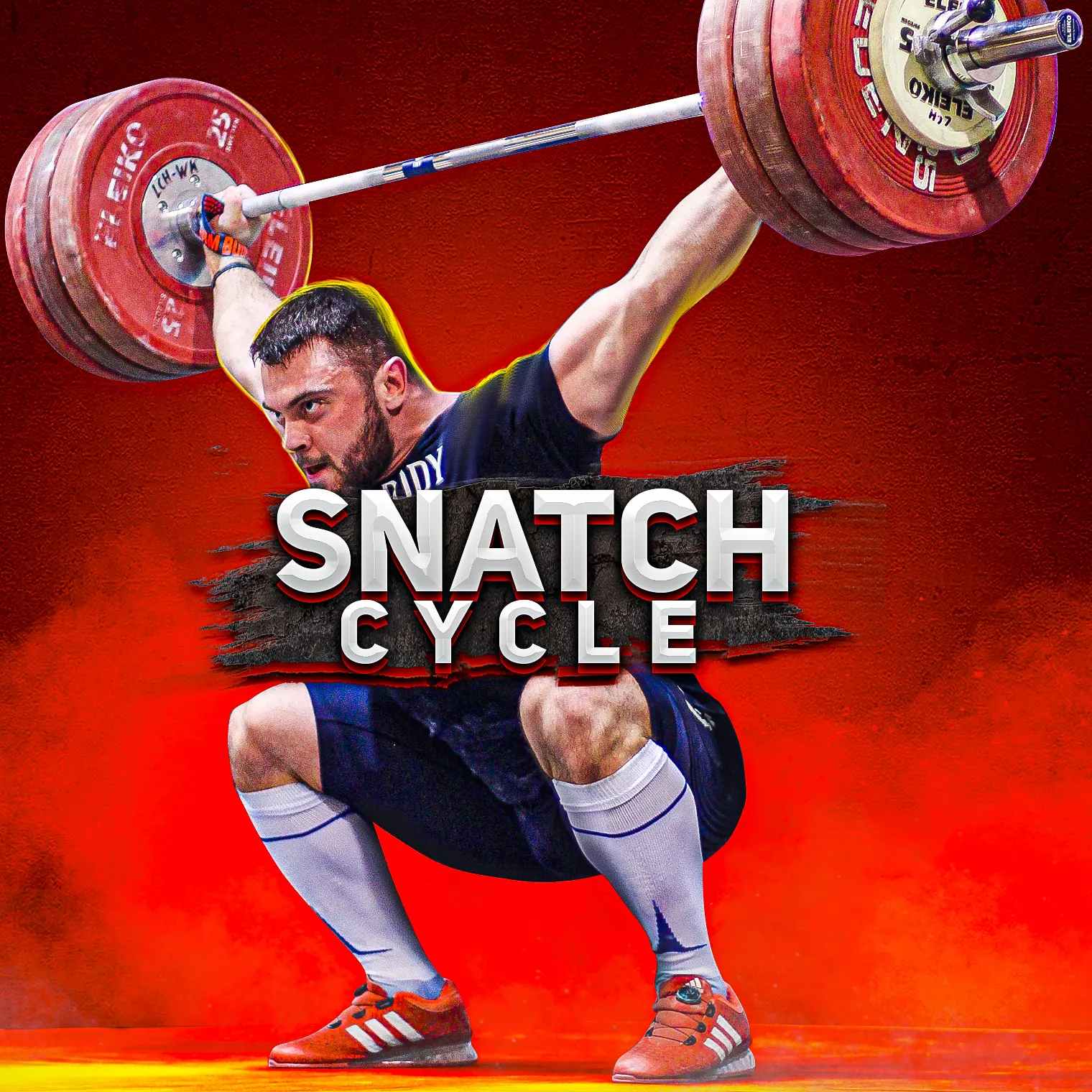

Still have questions after reading our article? Unlock your full potential by engaging with our experts and community! Don’t hesitate — leave a comment below and Oleksiy Torokhtiy will provide a personalized answer and insights to help you reach your goals.